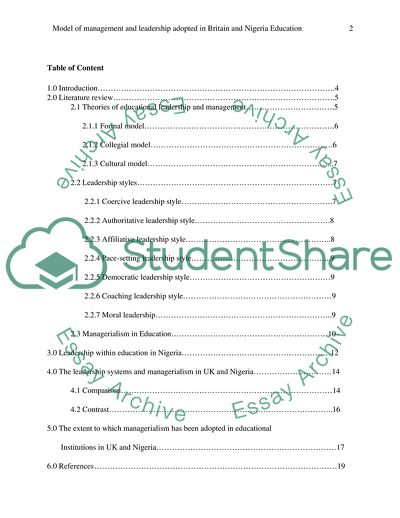Cite this document
(Model of Management and Leadership Adopted in Britain and Nigeria Education Term Paper Example | Topics and Well Written Essays - 4250 words, n.d.)
Model of Management and Leadership Adopted in Britain and Nigeria Education Term Paper Example | Topics and Well Written Essays - 4250 words. https://studentshare.org/education/1859649-explore-to-what-extent-the-managerialist-model-of-management-and-leadership-adopted-in-britain-education-and-how-it-has-influenced-management-culture-in-nigeria-and-the-impact-that-this-may-have-on-your-personal-experience-on-management-and-leadership-sty
Model of Management and Leadership Adopted in Britain and Nigeria Education Term Paper Example | Topics and Well Written Essays - 4250 words. https://studentshare.org/education/1859649-explore-to-what-extent-the-managerialist-model-of-management-and-leadership-adopted-in-britain-education-and-how-it-has-influenced-management-culture-in-nigeria-and-the-impact-that-this-may-have-on-your-personal-experience-on-management-and-leadership-sty
(Model of Management and Leadership Adopted in Britain and Nigeria Education Term Paper Example | Topics and Well Written Essays - 4250 Words)
Model of Management and Leadership Adopted in Britain and Nigeria Education Term Paper Example | Topics and Well Written Essays - 4250 Words. https://studentshare.org/education/1859649-explore-to-what-extent-the-managerialist-model-of-management-and-leadership-adopted-in-britain-education-and-how-it-has-influenced-management-culture-in-nigeria-and-the-impact-that-this-may-have-on-your-personal-experience-on-management-and-leadership-sty.
Model of Management and Leadership Adopted in Britain and Nigeria Education Term Paper Example | Topics and Well Written Essays - 4250 Words. https://studentshare.org/education/1859649-explore-to-what-extent-the-managerialist-model-of-management-and-leadership-adopted-in-britain-education-and-how-it-has-influenced-management-culture-in-nigeria-and-the-impact-that-this-may-have-on-your-personal-experience-on-management-and-leadership-sty.
“Model of Management and Leadership Adopted in Britain and Nigeria Education Term Paper Example | Topics and Well Written Essays - 4250 Words”. https://studentshare.org/education/1859649-explore-to-what-extent-the-managerialist-model-of-management-and-leadership-adopted-in-britain-education-and-how-it-has-influenced-management-culture-in-nigeria-and-the-impact-that-this-may-have-on-your-personal-experience-on-management-and-leadership-sty.


